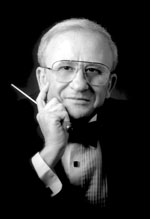|
By David Amos
 SAN DIEGO—I am often asked in casual social conversation, or during, or after lectures, about distinguishing good, outstanding music-making from the routine and pedestrian. Although the performer is the one conveying the artistic message and the audience is the one receiving it, the elements are really the same. SAN DIEGO—I am often asked in casual social conversation, or during, or after lectures, about distinguishing good, outstanding music-making from the routine and pedestrian. Although the performer is the one conveying the artistic message and the audience is the one receiving it, the elements are really the same.
One thing for sure: The worst kind of music is dull, colorless music. To me, this is an artistic crime. This could be because the composition’s quality is questionable, or more often than not, it is the fault of the interpreter. You have heard the old saying, that a great actor will elicit an emotional response from an audience by just reciting the alphabet? The same applies to music.
I have attended many a concert and recital with world-class performers. Sometimes, the experience is wonderful and the artist comes through as advertised. But you can not assume that they will be automatically great. Even our beloved superstars have their off-nights. No human being can be at his/her creative, artistic and energetic best 365 days a year! When this happens, you do not necessarily hear wrong notes or sloppy playing, but colorless, lifeless playing or singing.
An artist starts by looking at a piece of music that is to be prepared for concert. What goes into this preparation? Obviously, the technical aspects, learning the notes, rhythms, tempos, balances, to play it in tune, and so on. But what make for true music communication are the other factors. The tradition behind other great interpreters of the past, the message of the composer, a good knowledge of his style, and most important, the subtleties, shadings, colors, and personal interpretation where the performer adds his/her personal touch. All of this has to come together once the concert or recording starts.
In 1990, I was about to conduct the London Symphony Orchestra in a recording. I worked out all the details of the conducting and rehearsing process of that particular composition, but the meaning behind the music was still unclear to me. I spent two long nights in my Paris hotel room, probing, studying, and somewhat concerned as the recording date and flight to London was approaching. The inspiration
Go to the top of right column
|
|
finally hit me very suddenly the night before departure; I understood what I needed to do to convey the spirit of the music, it all became illuminated, and everything worked out very well. It can be a grueling mental process, but it is most satisfying when it works out. And invariably, it does.
Do you want to hear perfection of style, where everything is just right? Listen to recordings of Artur Rubinstein playing Chopin.
This formula applies to instrumental soloists, ensembles, singers, conductors, and to anyone who participates in the musical conveyance. Larger groups, such as orchestras, choruses or ballet ensembles are usually more consistent and respond to the signals of the leader or coach, assuming that there are no negative outside forces impeding their ability to give their best.
Here are a few other key phrases on effective music-making, which I have heard through the years: A conductor is not just a time beater, but he better be an outstanding time beater! Music can be soft and slow, and at the same time be very vibrant and exciting. The subtleties in the music are what makes an interesting performance; listen as to how each phrase is turned and caressed. Is there energy flowing between the stage and the audience? Are we witnesses to magical inspiration, or just notes?
Music can be precise, loud, dynamic, and propulsive, but be totally uninspiring, performed by a hack interpreter.
Publicity is irrelevant. Sometimes the media darlings are not necessarily the best musicians out there. Be careful who you worship! Look past the glitter, fame, publicity, big money, or even the dazzling technique of an artist (The latter can be deceiving to all of us), and delve deeper. Sometimes, the emperor is not wearing any clothes! Real, sincere musical communication is probably best found in the vast, gray area of musicians who are not household names, but are the true messengers of the art form. There is a lot of pleasure to be found in exploring and discovering lesser known talent. It’s there, believe me.
Great music has to touch our souls. The more we know about the music and the more we experience it, the deeper it reaches us.
|
|

